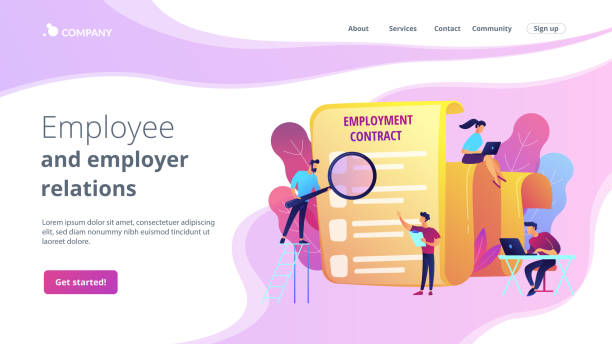Introduction to Responsive Web Design and Its Importance

In today’s world, where the rapid pace of technological growth and the diversity of smart devices is astounding, responsive website design is no longer a luxury option, but rather a strategic necessity. The concept of #Responsive_Design or #Responsive_Web_Design refers to a structure and layout that enables your website to intelligently adapt its form and content to different screen dimensions of the user, from desktop computers and large laptops to tablets and smartphones. This approach ensures that the user experience on any device is seamless and optimal, regardless of screen size or resolution. The main goal is to provide a flawless visual and functional experience, allowing visitors to easily access the desired content without needing to zoom, horizontal scroll, or any manual adjustments.
The importance of this type of design is more evident than ever in the current era. Given that a significant portion of internet traffic comes from mobile devices, a website not optimized for mobile not only provides a bad user experience but can also lead to the loss of potential customers. Google has also explicitly stated that it prefers responsive websites in its search rankings, which is a decisive reason for the necessity of implementing responsive website design. In fact, this is a fundamental step towards achieving better SEO and increasing your website’s accessibility. This descriptive and educational section introduces you to the basic concepts.
Are you tired of losing business opportunities due to not having a professional corporate website?
Rasaweb helps you with professional corporate website design:
✅ Build a powerful and reliable brand image
✅ Convert site visitors into loyal customers
⚡ Get a free consultation now!
Basic Principles of Responsive Design

To deeply understand responsive website design, one must become familiar with its three key principles: Fluid Grids, Flexible Images, and Media Queries. These three elements work together to ensure your website displays correctly on any screen size. Fluid grids use relative units like percentages for element widths instead of fixed pixel units. This approach allows page elements to proportionally resize with the screen size, without breaking the layout or making content unreadable.
Flexible images ensure that images and videos intelligently adjust to the width of their container. This means a large image on a desktop screen automatically becomes smaller to fit on a mobile phone screen, without needing manual resizing. This is usually achieved by setting the max-width: 100%; property in CSS, which prevents the image from overflowing its container.
The most crucial component is media queries. These are CSS instructions that tell the browser when and how to apply specific styles based on device characteristics such as screen width, height, orientation, or resolution. For example, you can define rules that, on smaller screens, website columns stack below each other instead of side-by-side. This specialized feature forms the core of every responsive website design project and allows for precise control over the user experience on different devices. Understanding these principles is vital for anyone intending to design a modern website. This section is educational and specialized.
Implementation Techniques for Responsive Design

Implementing responsive website design requires the use of specific techniques in HTML and CSS coding. One popular and highly effective approach is the Mobile-First approach. In this method, you first design and code your website for the smallest screens (mobile phones) and then gradually add styles for larger screens like tablets and desktops using Media Queries. This method ensures that your website’s mobile version is lightweight, fast, and optimized, as you only load essential resources for it and then add extra capabilities for larger devices as needed. This contrasts with the Desktop-First approach, which can lead to excessive loading of unnecessary CSS and JavaScript on mobile devices.
Alongside Mobile-First, using the Viewport Meta Tag in the <head> section of the HTML page is mandatory: <meta name="viewport" content="width=device-width, initial-scale=1.0">. This tag instructs the browser to match the page width with the device width and set the initial scale to 1, which is crucial for correct website display on mobile devices. Furthermore, using relative units like em, rem, vw, vh instead of px for font sizes and spacing helps the design be more flexible. These are specialized and guiding parts for any responsive design.
In here a table for comparing common CSS measurement units is provided:
| Unit | Description | Application in Responsive Design |
|---|---|---|
| px | Pixel (absolute unit) | Suitable for small, fixed elements, but less recommended for responsiveness. |
| em | Relative to parent’s font size | Excellent for font sizes and spacing that should scale with text. |
| rem | Relative to root font size | Suitable for font sizes and spacing that should uniformly change across the entire site. |
| % | Percentage (relative to parent) | Very suitable for element widths in fluid grids. |
| vw/vh | Percentage of viewport width/height | Useful for full-screen design and elements that should always occupy a specific portion of the screen. |
User Experience in Responsive Design

Responsive website design is not merely about correctly displaying the website on different devices; it profoundly impacts User Experience (UX). A responsive website is designed so that navigation, interaction, and content access are easy and intuitive on any device. This includes optimizing button sizes for touch, ensuring font readability on small screens, and logically arranging content so users can easily find the information they need without unnecessary zooming or scrolling. For instance, navigation menus that might appear horizontally on a desktop may transform into a “hamburger” icon on mobile to optimize screen space.
User experience challenges in this area include ensuring high loading speed on mobile devices (which may have weaker internet connections) and managing high-quality images. Designers must consider optimizing images for different devices and using Lazy Loading techniques so that images only load when the user reaches that part of the page. Furthermore, attention to touch interactions is crucial. Buttons should be large enough to be easily tapped with a finger, and small, closely spaced elements that could lead to incorrect selections should be avoided. Responsive website design must address these precise and analytical points to provide a flawless user experience. This section is analytical and descriptive.
Are you worried about losing customers because you don’t have a professional e-commerce site?
With e-commerce website design by Rasaweb, forget these worries!
✅ Significant increase in sales and conversion rate from visitor to customer
✅ Professional and user-friendly design that builds customer trust
⚡ Get a free consultation from Rasaweb
Popular Tools and Frameworks

To facilitate the process of responsive website design and accelerate development, numerous tools and frameworks are available that help designers and developers build responsive websites with greater efficiency. Among the most popular and powerful of these is Bootstrap. Bootstrap is a CSS, HTML, and JS framework that includes ready-to-use components such as a responsive grid system, navigations, buttons, and forms. This framework allows developers to quickly create responsive layouts using pre-defined CSS classes without needing to write a lot of CSS code from scratch.
Tailwind CSS is another widely used framework that takes a different approach. Instead of providing ready-made components, Tailwind offers a set of utility classes that you can apply directly in your HTML to create highly custom styles. This approach gives designers more control over the final appearance and generates less CSS code. Tools like Flexbox and CSS Grid are also native CSS capabilities that have revolutionized responsive layouts. Flexbox is very powerful for arranging elements in one dimension (row or column), and Grid for arranging in two dimensions (rows and columns), and they can replace many traditional responsive techniques. Using these tools is vital for any modern web design professional. This section is specialized and provides guidance.
Challenges and Solutions in Responsive Design

Despite its numerous advantages, implementing responsive website design is not without its challenges. One of the biggest concerns is Performance Management of the website on different devices. Responsive websites might load slowly on mobile devices with low internet speeds due to high-quality images or large CSS and JS files. The solutions for this challenge include image optimization (compression and using next-gen formats like WebP), Lazy Loading for off-screen content, and clean and efficient coding. Using a CDN (Content Delivery Network) can also improve loading speed for users in various geographical regions.
Another challenge is the complexity of testing. With countless devices, browsers, and screen dimensions, ensuring the website displays correctly in all scenarios can be difficult. Using browser simulator testing tools, testing on real devices, and multi-browser testing services like BrowserStack can help you in this regard. Additionally, content management is also a challenge; some content that appears suitable on desktop might be too long or complex on mobile. Reviewing content and ensuring it is concise and scannable for mobile users is of high importance. This section contains thought-provoking and analytical content, which helps you approach responsive web design with greater care.
Impact of Responsive Design on SEO

Responsive website design not only improves user experience but also has a direct impact on Search Engine Optimization (SEO). Google has repeatedly emphasized that it prefers mobile-friendly websites in its search results, especially with the introduction of Mobile-First indexing. This means Google primarily checks your website’s mobile version for crawling and indexing, and if your mobile version is not optimized, your SEO ranking might decrease. A responsive website does not require managing two separate versions (desktop and mobile), which itself helps reduce SEO errors like duplicate content or incorrect redirects.
Furthermore, responsive websites typically have a lower Bounce Rate and higher dwell time, because users have a better user experience and are more inclined to stay on the site. These factors indirectly influence your SEO, as search engines consider these metrics as indicators of content quality and user relevance. Improved loading speed on mobile devices, a natural outcome of responsive website design, is also considered an important ranking factor by Google. Finally, having a single URL for all devices helps with easier sharing and link-building, which again benefits SEO. This analytical and descriptive section shows how a responsive website is a smart investment in SEO.
In here a comparative table of the impact of responsive design on key SEO factors is provided:
| SEO Factor | Impact of Responsive Design | Description |
|---|---|---|
| Mobile-First Indexing | Positive (Essential) | Google primarily indexes your site’s mobile version. Responsive website meets this requirement. |
| Page Loading Speed | Positive | Responsive design typically leads to optimized loading speed on mobile. |
| Bounce Rate and Dwell Time | Positive | Better user experience results in lower bounce rate and longer dwell time. |
| Link Building and Sharing | Positive | A single URL for all devices simplifies the link-building process. |
| Duplicate Content | Negative (Prevented) | With content consistency across all devices, the risk of duplicate content is eliminated. |
The Future of Web Design and the Role of Responsiveness

As technology advances at a stunning pace, responsive website design is also evolving, and its role in the future of web design will become more prominent. New devices such as smartwatches, wearables, and even curved displays present new challenges for designers. In the future, “responsiveness” will go beyond screen dimensions and will mean adaptability to the user’s context; including location, internet connection speed, ambient light level, and even the user’s emotional state. This level of adaptability can elevate the user experience to entirely new dimensions.
Concepts like Progressive Web Apps (PWA), which offer a combination of the best features of web and native applications, are gaining popularity and heavily rely on responsive approaches. PWAs can work offline, send notifications, and even be added as an icon to the phone’s home screen, while still essentially being a website. Furthermore, advanced CSS techniques like Container Queries, which allow responsiveness based on the size of a parent element rather than the entire viewport, are under development. These news and entertaining advancements indicate that responsive website design will not only endure but will increasingly become smarter and more sophisticated to meet the diverse needs of users in the growing digital ecosystem.
Does your current corporate website present a worthy image of your brand and attract new customers?
If not, turn this challenge into an opportunity with Rasaweb’s professional corporate website design services.
✅ Significantly improves your brand’s credibility and image.
✅ Paves the way for lead generation and new customer acquisition for you.
⚡ Contact Rasaweb now for free and specialized consultation!
Steps to Execute a Responsive Design Project

To ensure the success of a responsive website design project, following a systematic process is essential. This process covers everything from initial planning to final deployment. The first stage is planning and research. In this step, the target audience, website goals, and types of devices users will utilize must be identified. Additionally, competitor analysis and content gathering are of high importance.
The second stage is User Interface (UI) and User Experience (UX) design. In this stage, wireframes and mockups are created to display the website’s layout and appearance across various screen sizes. The Mobile-First approach is very effective at this stage. Focusing on simple navigation, touchable buttons, and text readability on mobile is crucial. The third stage is development and coding. In this step, HTML, CSS, and JavaScript code are written to implement the responsive design. Using appropriate frameworks and libraries can increase speed and efficiency.
The fourth stage is testing and optimization. The website must be tested on various devices and browsers to ensure correct functionality and error-free display. Loading speed optimization and resolving potential issues are performed at this stage. Finally, the fifth stage is deployment and maintenance. After ensuring final quality, the website is deployed on the server, and continuous monitoring of performance and necessary updates for compatibility with new technologies and user needs continues. These stages provide comprehensive guidance for a successful responsive design project. This section is guiding and educational.
Why Your Business Needs Responsive Website Design

In today’s digital age, having a website is vital for any business, but having a responsive website design has become increasingly important for survival and growth in the competitive market. The first reason is wider accessibility. More than half of global web traffic comes from mobile devices. If your website does not display correctly on these devices, you effectively lose a large portion of your potential customers. A responsive website ensures that every user, regardless of the device they use, can access and interact with your content.
The second reason is improved SEO and search engine rankings. As mentioned earlier, Google prefers mobile-friendly websites and implements Mobile-First indexing. A responsive website helps you achieve a better ranking in search results, which means increased visibility and more traffic for your business. The third reason is a superior user experience, which directly leads to higher conversion rates. Today’s users are impatient and in a hurry; if your website is slow or doesn’t offer a good mobile experience, they will quickly leave it. A smooth and optimized user experience encourages customers to stay longer on your site, browse products, and ultimately take your desired action (such as purchasing or filling out a form).
The fourth reason is easier and more cost-effective maintenance. Instead of developing and maintaining two separate versions (a desktop website and a separate mobile website), you have only one website that meets the needs of both platforms. This reduces development and maintenance costs and simplifies content management. In summary, investing in responsive website design is a smart and strategic decision for any business looking for growth and success in the online space. This section is descriptive and analytical, outlining compelling reasons for the need for a modern website.
Frequently Asked Questions
| Question | Answer |
|---|---|
| What is responsive website design? | A method in web design where the site adapts to the screen size of different devices (desktop, tablet, mobile). |
| Why is responsive design important? | To provide an optimal user experience on any device the user employs and to improve SEO. |
| What are the main techniques of responsive design? | Using fluid grids, flexible images, and Media Queries. |
| What is a Media Query? | A CSS rule that allows applying different styles based on screen characteristics (such as width or height). |
| What are the benefits of responsive website design? | Increased user satisfaction, improved site ranking in search engines (SEO), reduced maintenance costs compared to having separate versions for each device. |
And other services by Rasaweb Advertising Agency in the field of advertising
Smart Reportage: An innovative service to increase customer acquisition through marketing automation.
Smart Conversion Rate Optimization: A professional solution for user interaction focusing on marketing automation.
Smart Marketplace: A dedicated service for campaign management growth based on custom programming.
Smart Custom Software: A creative platform to improve customer acquisition with Google Ads management.
Smart Brand Identity: Revolutionize customer acquisition with the help of user experience customization.
And over hundreds of other services in the field of internet advertising, advertising consultation, and organizational solutions
Internet Advertising | Advertising Strategy | Advertorial
Sources
Digital Transformation and Responsive Site
The Importance of Responsive Website Design
Comprehensive Guide to Digital Transformation
The Role of Website in Organizational Transformation
? With Rasaweb Afarin, the digital future of your business is in our hands. We ensure a powerful and impactful presence for you by providing comprehensive services in SEO, content marketing, and multilingual website design.
📍 Tehran, Mirdamad Street, next to Bank Markazi, Kazerun Jonoubi Alley, Ramin Alley, No. 6




